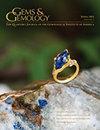巴洛克时代彩色宝石的玫瑰切割:从17世纪下半叶的亮点
IF 1.6
3区 地球科学
Q2 MINERALOGY
引用次数: 0
摘要
2020年冬季GEMS&GEMOLOGY玫瑰剪裁包括各种贴面安排,所有这些都没有一张平板(图1)。与大量关于在钻石中使用玫瑰切割的文献相反,关于玫瑰切割在彩色宝石中的使用的信息却很少。钻石成型的故事始于对天然钻石八面体的晶面进行抛光和/或轻微修改,创造出所谓的点切割。此后,从15世纪开始,简单的餐桌切割开始发展,随着时间的推移变得越来越复杂(Lenzen,1966;福尔克,1975年;蒂兰德,1995年;克莱因,2005年;吉尔伯森,2007年;奥格登,2018)。玫瑰切割的钻石后来成为十六世纪和十七世纪的典型产品,采用的切割工艺始于钻石八面体的粗糙解理碎片。标准的外观通常包括一个平坦的底座,顶部是一个圆顶,中心有六个三角形的小平面。在圆顶顶部和底部之间是一个中间层,具有6个、12个或18个额外的刻面(图2)。尽管在术语上存在一些不一致,但这些切口主要分别表示为安特卫普玫瑰(6+6个刻面)、半荷兰玫瑰(6+12个刻面的)和全荷兰玫瑰(6/18个刻面的)(Eppler和Eppler,1934;Stranner,1953)。钻石切割的上述历史进展的视觉证据很容易在描绘过去时代珠宝物品的参考文献和17世纪金匠或珠宝设计师的素描本中找到,如T.Cletcher(1629)或G.Légaré(1663)(图3;例如,见Gans,1961;沃尔格雷夫,1993a,b;Scarisbrick,1993)。Kockelbergh等人(1992)和De Bie(2014)讨论了与玫瑰切割钻石开发有关的政治和经济环境。在关于没有平桌切割的彩色宝石的文献中,这种刻面宝石在艺术中的首次出现是在a.Bronzino(1542)16世纪的一幅画中发现的,该画描绘了金星、丘比特、愚蠢和时间(欲望的寓言)(见Prim,2018)。该作品中的椭圆形宝石显示了一个由多个细长菱形镶嵌面覆盖的王冠。十六世纪下半叶和十七世纪的其他孤立艺术和珠宝也提供了几个例子(例如,见Prim,2019)。1912年,在1666年伦敦大火之前,人们发现了所谓的谢普塞德贮藏所,当时出现了大量展示无平桌切割彩色石头的物品。示例包含在为2014年展览BAROQUE-ERA ROSE彩色石头切割:十七世纪后半叶的亮点准备的目录中本文章由计算机程序翻译,如有差异,请以英文原文为准。
Baroque-Era Rose Cuts of Colored Stones: Highlights from the Second Half of the Seventeenth Century
GEMS & GEMOLOGY WINTER 2020 Rose cuts encompass a variety of faceting arrangements, all of which lack a flat table (figure 1). In contrast to the considerable literature on the use of rose cuts in diamonds, there has been a dearth of information regarding their use in colored stones. The story of diamond fashioning started with the polishing and/or slight modification of the crystal faces of natural diamond octahedra, creating what is known as the point cut. Thereafter, simple table cuts were developed from the fifteenth century onward, becoming more complex over time (Lenzen, 1966; Falk, 1975; Tillander, 1995; Klein, 2005; Gilbertson, 2007; Ogden, 2018). Diamonds with rose cuts came later as a typical product of the sixteenth and seventeenth centuries, employing a cutting process that began with a rough cleavage fragment from a diamond octahedron. The standard appearance generally consisted of a flat base topped by a dome with six triangular facets at the center. Between the dome top and the base was an intervening layer with six, 12, or 18 additional facets (figure 2). Despite some inconsistency in terminology, these cuts are primarily denoted as Antwerp roses (6 + 6 facets), half-Dutch roses (6 + 12 facets), and full-Dutch roses (6 + 18 facets), respectively (Eppler and Eppler, 1934; Stranner, 1953). Visual evidence of the foregoing historical progression in diamond cuts is readily found in references depicting jewelry objects from bygone eras and in seventeenth-century sketchbooks of goldsmiths or jewelry designers such as T. Cletcher (1629) or G. Légaré (1663) (figure 3; see, e.g., Gans, 1961; Walgrave, 1993a,b; Scarisbrick, 1993). Political and economic circumstances related to the development of rose-cut diamonds are discussed by Kockelbergh et al. (1992) and De Bie (2014). In the decidedly less voluminous literature on colored stones cut without flat tables, the first appearance of such a faceted gemstone in art is found in a sixteenth-century painting by A. Bronzino (1542) portraying Venus, Cupid, Folly, and Time (an allegory of lust) (see Prim, 2018). The oval gemstone in that work shows a crown covered by multiple facets in the form of elongated rhombuses. Other isolated art and jewelry pieces from the second half of the sixteenth century and the seventeenth century likewise offer several examples (see, e.g., Prim, 2019). A notable influx of items displaying colored stones cut without flat tables then occurred with the 1912 discovery of the so-called Cheapside Hoard, dated before the Great Fire of London in 1666. Exemplars are contained in the catalog prepared for the 2014 exhibition BAROQUE-ERA ROSE CUTS OF COLORED STONES: HIGHLIGHTS FROM THE SECOND HALF OF THE SEVENTEENTH CENTURY
求助全文
通过发布文献求助,成功后即可免费获取论文全文。
去求助
来源期刊

Gems & Gemology
地学-矿物学
CiteScore
2.90
自引率
19.20%
发文量
10
期刊介绍:
G&G publishes original articles on gem materials and research in gemology and related fields. Manuscript topics include, but are not limited to:
Laboratory or field research;
Comprehensive reviews of important topics in the field;
Synthetics, imitations, and treatments;
Trade issues;
Recent discoveries or developments in gemology and related fields (e.g., new instruments or identification techniques, gem minerals for the collector, and lapidary techniques);
Descriptions of notable gem materials and localities;
Jewelry manufacturing arts, historical jewelry, and museum exhibits.
 求助内容:
求助内容: 应助结果提醒方式:
应助结果提醒方式:


